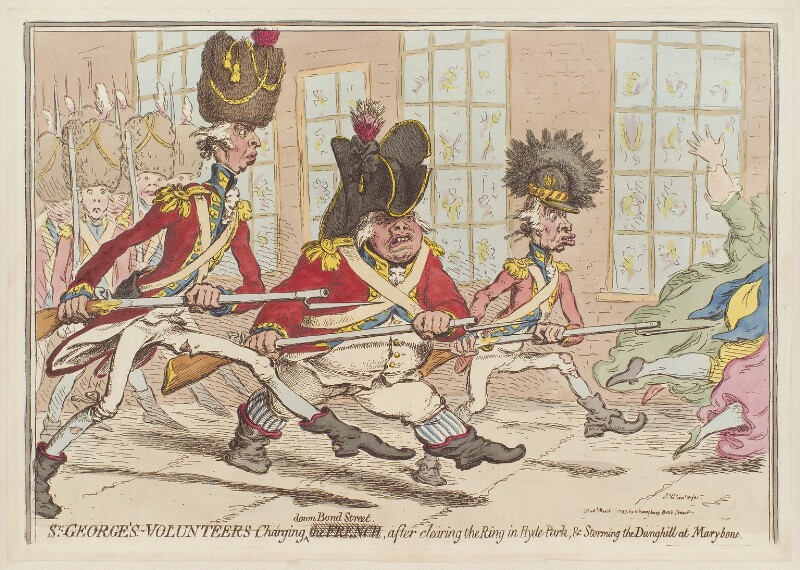
Courtesy of NPG
Origins
The history of the Rifle Volunteer movement stems from the need and desire to raise and train volunteers to counter the threat from Napoleon.
The St George’s Volunteers date from this time of perceived invasion threat, and the Corps was sufficiently known to warrant a Gillray caricature, which was as ever, not entirely complimentary, but the Regiment found itself in good company (see above, image courtesy of NPG).
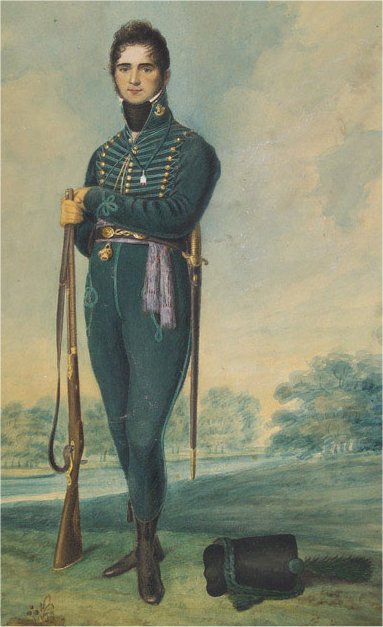
(Courtesy of the National Army Museum)
The St George’s Volunteers were succeeded by the The Duke of Cumberland’s Corps of Sharpshooters, which were inaugurated in September 1803. Capt Barber who commanded the Corps produced a manual of rifle drills in use at the time.
The Sharpshooters became the Royal Victoria Rifle Club in 1835, thereby avoiding disbandment, and gaining the patronage of the young Princess Victoria.
The Crimea, the Orsini Affair and the Imperial calls on the Army led to further formalisation, as did the Duke of Wellington’s letter to Sir John Bourgoyne in 1847 supporting the Rifle Volunteer movement.
They formally embodied as a rifle club in 1852, and as a Regiment in 1853, with the first officers commissions were formally gazetted on 4 January 1853.
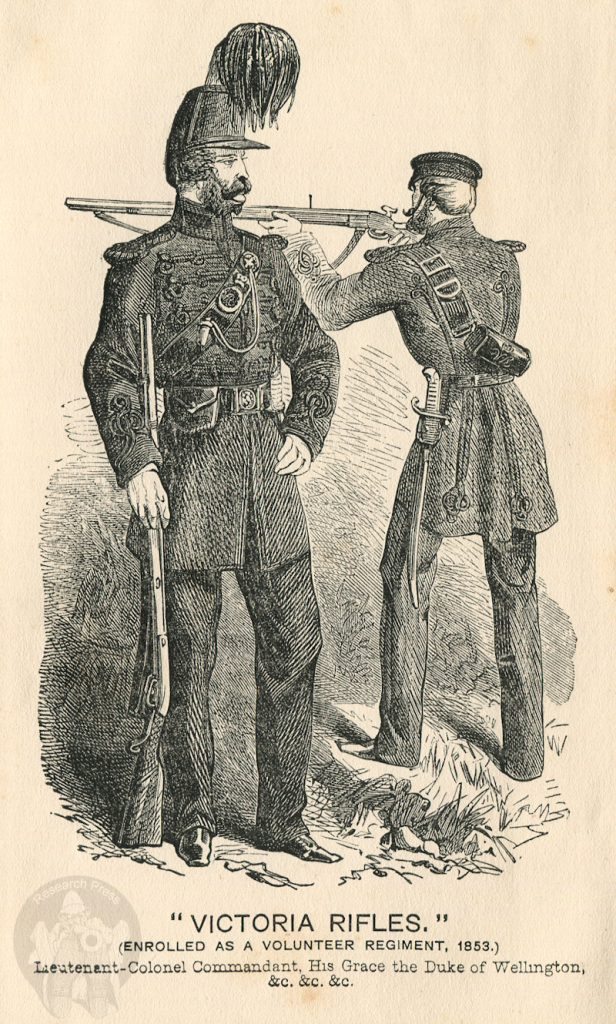
Courtesy of Research Press
Retitled in 1859 as the 1st Middlesex Rifle Volunteer Corps, they were was formalised as Second in the Order of Precedence of the Volunteer Corps behind the Exeter and South Devon Volunteer Rifle Corps the following year, not without some significant objection to being second to anyone.
The Volunteers were generally an urban upper middle class choice. Barrie Rose noted in his article ‘the Volunteers of 1859‘ (Journal of the Society for Army Historical Research Vol 37 No 151 Sept 1959):
“The uniform cosy £14, the rifle a further £6 6s, and the fees and incidentals were so high that many young men of the middle classes were debarred from joining“
Even in this context, the Regiment was considered socially prestigious, and considered in the same context as the HAC, and W H Blanch noted in his Volunteer’s Book of Facts in 1862 that both establishments…
“debarred entry to anyone polluted with trade.”
The Victorias were the first Volunteer Corps which received formal sanction for the formation of ‘Mounted Infantry’ (a company of which was transferred to the Yeomanry earning an East Kent militia the right to call themselves the Sharpshooters) and the Victorian age saw them maintain their reputation winning The Queen’s Prize twice, the Wimbledon Cup, the Alexandra, the Association Cup, the (Snider) Association Cup, and the Duke of Cambridge’s Prize, all rifle shooting competitions of note.
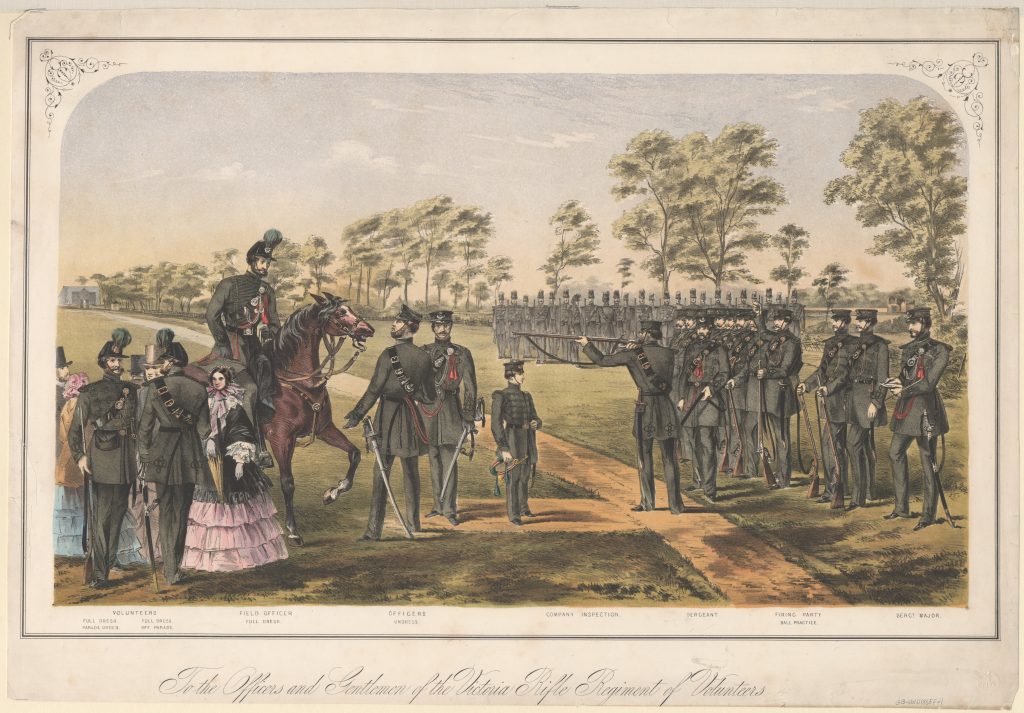
By 1892 the 1st Middlesex and 6th (St George’s) Rifle Volunteer Corps were linked together with Headquarters at St John’s Wood and Davies Street respectively. Both had also been linked as Volunteer Battalions of the King’s Royal Rifle Corps back in 1881. It was also at this point that Keeson writing the Regimental History laments the passing of the uniform:
“The gorgeous and expensive uniform of the old Victoria Rifles has been superseded by the neat and serviceable pattern of the KRR.“
In 1900 the South African War saw the Regiment contribute to the City of London Imperial Volunteers and to the KRRC, with Shipley and Ellis both in action. Shipley also commanded the 250 officers and men who embarked on the Garth Castle, giving an indication of his standing in the CIV.
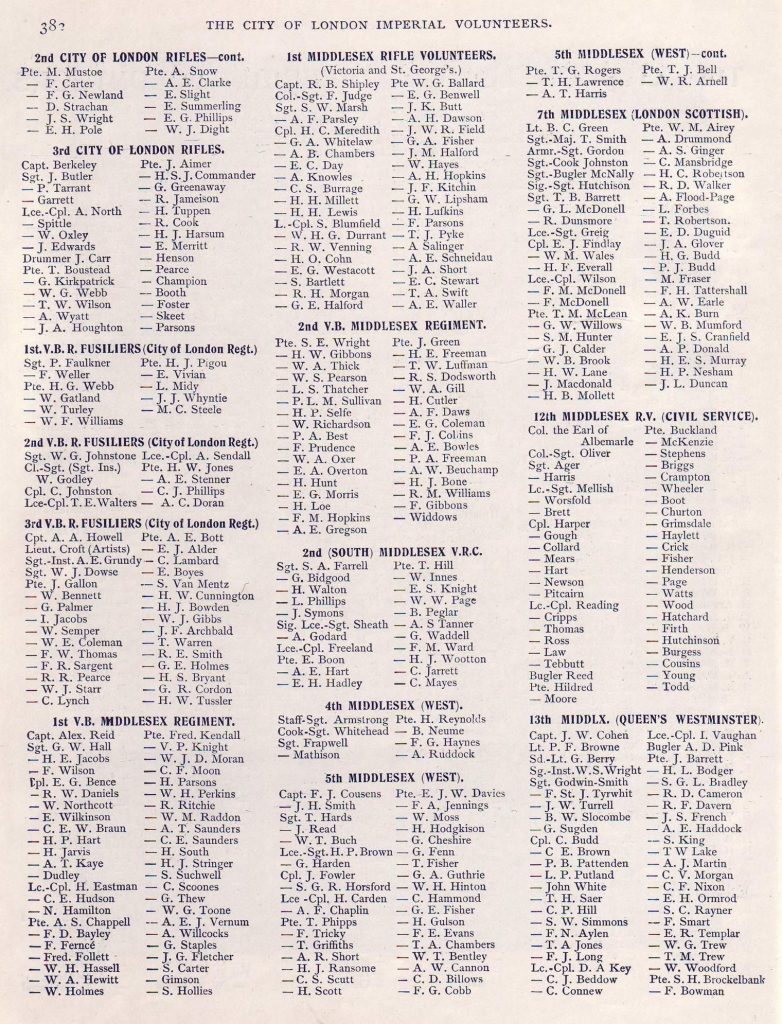
In 1908 the Territorial and Reserve Forces Act was passed and the new Territorial Force was created. At this time the Regiment amalgamated with the 19th Middlesex (St Giles and St George’s, Bloomsbury) Volunteer Rifle Corps to form the 9th (County of London) Battalion, London Regiment (Queen Victoria’s Rifles).
As part of these reforms, mounted infantry, which had been an innovation practised by the Victoria Rifles notably in South Africa became the purview of the Yeomanry Regiments. This saw the Mounted Infantry Company of the Victoria & St George’s, commanded by Captain O A Howell, transferred en bloc to form B Squadron of the 3rd County of London Yeomanry (Sharpshooters), what is today the Kent and Sharpshooters Yeomanry, establishing that unit’s connection to the Duke of Cumberland’s Sharpshooters.
World War 1
The Great War saw the creation of a second battalion, the 2/9th Londons.
1/9th Battalion, commanded by Lt Col Shipley, landed at Le Havre in November 1914 and were attached to the 13th Brigade of the 5th Division. The Officers Roll below lists a number of other Lodge members: the 2i/c Major Dickins, the MO Capt Roe (‘the Doc’), B Company’s 2i/c Capt Cox (whose brother served in C Coy) and the OC Depot Capt Hunter:
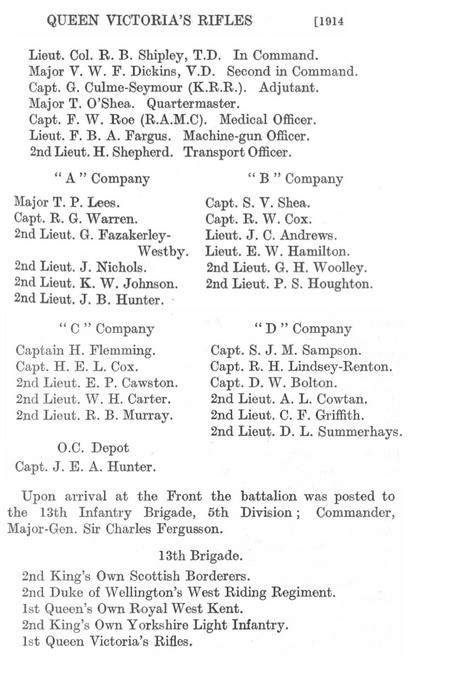
On 17 April 1915, the 13th Brigade mounted an attack on Hill 60, a small promontory on the edge of the Ypres Salient. It was during this fierce battle that Lieutenant Geoffrey Harold Woolley left a position of safety to take command of the soldiers on the Hill. The situation quickly deteriorated, with many men and all the other officers on the hill being killed. Woolley refused verbal and written orders to withdraw, saying he and his company would remain until properly relieved. They repelled numerous attacks through the night. When they were relieved the next morning, he returned with 14 men remaining from the 150-strong company. For his gallantry Lieutenant Woolley was awarded the Victoria Cross, the first to be won by the Territorial Force.
In 1916 command passed to Shipley’s Second in Command and fellow Lodge member, Lt Col Dickins. Meanwhile the 2/9th was commanded by Lt Col Langworthy-Parry, who would go on to command the 1st Battalion in 1921.
Inter-war Years
In 1937, on the break-up of the London Regiment, the regiment was again linked with the King’s Royal Rifle Corps and became the Queen Victoria’s Rifles, The King’s Royal Rifle Corps and converted to motor cycles for reconnaissance.
During these years the 1st Battalion was commanded by Lt Col Keeson.
Second World War
At the outbreak of the Second World War, the 1st Bttn was serving as part of the 1st London Division and was designated a motor-cycle reconnaissance battalion, armed with revolvers instead of rifles. The CO was Lt Col Ellison-Macartney.
In May 1940, the Battalion was transferred to the 30th Infantry Brigade, under Brigadier Claude Nicholson, and was hurriedly sent across the English Channel, but, due to an error, their motor cycles and sidecars were left in England. They fought in the desperate siege of Calais between 23 and 26 May 1940, which bought valuable time for the British Expeditionary Force to be evacuated from Dunkirk. Suffering very heavy losses, most of the battalion were either killed or captured and the Battalion had to be reconstituted from scratch. It was after Calais that Tim Lucas made a daring escape from captivity, rowing himself back across the Channel.
After returning to the United Kingdom, in December, the Battalion became part of the war-raised 27th Armoured Brigade, then serving under command of the 9th Armoured Division, and was designated as the 7th Battalion, King’s Royal Rifle Corps on 1 April 1941.
The 2nd Battalion was likewise originally serving in a motorised reconnaissance role as part of the 2nd London Division until in December 1940, it was transferred to help create the 28th Armoured Brigade, then part of the 9th Armoured Division. The battalion was re-designated as the 8th Battalion, King’s Royal Rifle Corps the following month.
Cadet Battalions
In 1942 the Queen Victoria Rifles Cadet Corps was reformed as the 2nd Cadet Battalion, The King’s Royal Rifle Corps, following a Home Guard instruction was issued ordering each Home Guard battalion to raise a cadet unit. Lt Col R L Clark of Queen Victoria’s Rifles was given the task and on 15 May the Queen Victoria’s Rifles Cadet Corps was born. Over the next three years the unit expanded to five companies, which in April 1945 led to it being re-titled the 2nd Cadet Battalion, The King’s Royal Rifle Corps. In 1951 the 1st and 2nd Cadet Battalion were amalgamated. This resulted in the disposal of the Headquarters of the 1st Cadet Battalion at 42 Sun Street. In 1954 the Battalion office of the ‘new’ 1st Cadet Battalion was established at 56 Davies Street.
Post War
After the war, the Queen Victoria’s Rifles was merged with the Queen’s Westminsters to form the Queen’s Royal Rifles on 1 May 1961
For an overview of the names of the Regiment see this page.
A number of Commanding Officers and senior members of the Regiment have served the Lodge.
For a selection of articles about the Rifle Volunteer Movement see the last section of the Links Page.
For suggested books about the Regiment click here.